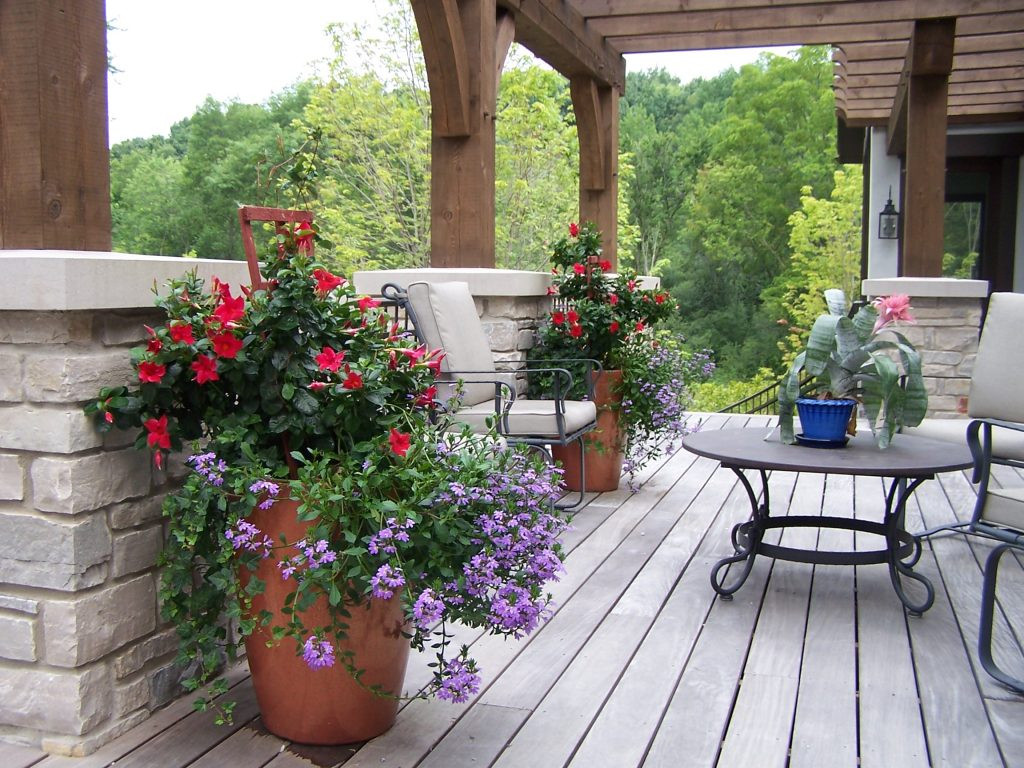OUTDOOR POTS PLANTED

Whether you are growing annuals, tropical, herbs or anything else, there are many good reasons to turn to containers. Plants raised in pots expand the presence of the landscape and garden to the patios, terraces, and walkways at once around the home. You can create sculptural focal points where they are needed and bring color and texture into otherwise empty areas.
Container plantings also draw butterflies, hummingbirds, and other pollinators, and they enliven the outdoor living space at a time when other areas of the garden have receded after spring.
For those in urban spaces, the container may be the only way to introduce eye-catching plants, including herbs and veggies, to your world.
We design beautiful flowerpot arrangements for homes and businesses and update them seasonally!
CONTAINER TYPES
Pots and planters are available in many materials and shapes, but a couple of principles apply to all of them. First, the larger the container, the less the stress on the plants, because soil moisture and temperatures will be more even. Second, the container must drain, unless you are growing pond plants. And resist the urge to place a saucer beneath a pot; doing so will lead to wet soil and root rot.
Larger pots are harder to manage and are more expensive than smaller ones, but a single large pot or a grouping of three, say, will have a presence that a clutter of small pots lacks.
“If you’re putting more than one plant in a pot, use a container at least 19 inches across, said Peter Atkins, from Peter Atkins and Associates who creates potted planters for our clients.
Mass-produced terra-cotta pots are affordable and handsome enough. Plastic versions keep moisture longer, but you may feel as if the world already has enough plastic. Glazed clay pots can complement a color scheme if you’re planting with one in mind.
Some containers and planters are wooden such as the half whiskey barrel being the obvious example. Other examples are concrete or reconstituted stone. Some of the most stylish containers are made of a resin mix and resemble stone, lead, or other natural materials.
SOIL MIXES Don’t use soil from the garden in pots; it’s too dense and will become saturated, which leads to root rot. Peter Atkins recommends making our own potting soil which consists of compost, sand, and screened soil. Sometimes we add woodchips, especially in deep pots too so that we do not need to fill the entire planter with soil making it dead weight. Adding compost like lobsters, cow, chicken will aid the plant for the season and cut down on the amount of miracle grow you need to buy for your pots. When planting large groups of plants this has worked very well for us.
PLANT OPTIONS Some of the most beloved summer annuals and perennials —elephant ear, coleus, lantana, calamint, rudbeckia and echinacea — have a place in the container garden.
If you’re going with annuals and tropical, the formula of thriller, filler and spiller still holds to be the correct layout of the potted pot. One starts with an upright starring plant (thriller), a plant cascading over the lip (spiller) and something to occupy the rest (filler).
FEEDING AND CARE
What’s the price of all this instant and movable beauty? Watering. Most containers will need a deep drink daily during the hottest weeks of the year.
You know the pot has been thoroughly soaked when water drains from the bottom. Try to water the soil rather than the foliage and do so before plants show any significant wilting.
Use a watering can or a soaker wand attached to the garden hose. The jet from a regular nozzle is too strong. I’ve seen setups with drip emitters and tubes; however, I wonder whether they deliver enough water, and besides, they make the container look as if it’s in intensive care.
Water your pots even when it rains. Containers are not sufficiently watered by nature, even in summer deluges. Your finger is the best tool for gauging soil moisture. Your eye is the next best tool; look for leaves that are flagging.
One way to reduce watering needs is to plant succulents such as agaves, sempervivum and sedums. Some succulents may need siting away from the scorching sun. The potted succulent garden presents a different effect — more desert than jungle. A mulch, we design beautiful flower pot arrangements for homes and businesses and update them seasonally! Green sphagnum or sheet moss that will lock in the moisture will complete the look.
Peter Atkin and Associates Signature Potted Container Business:
Schedule a Free Consultation, this will be the best meeting to learn how we can do you pots and match it to your furniture's, living art and the flower that exists in your gardens.
Consultations take up to 25 minutes. We will measure your pots, check your light condtions, show you examples, ask for your budget and offer you a quote for our planting services.
No pots? No problem. We have relationships with several local pottery vendors and can help you find the perfect planters for your space.
To Get Started Call Peter Atkins (914) 234-0161 and PeterHatkins62@gmail.com.